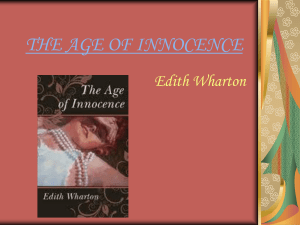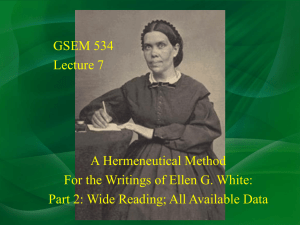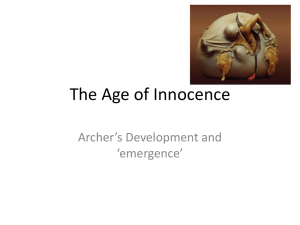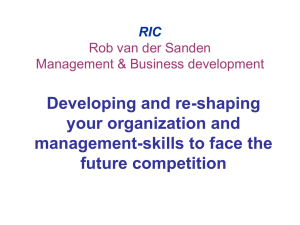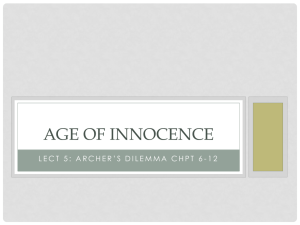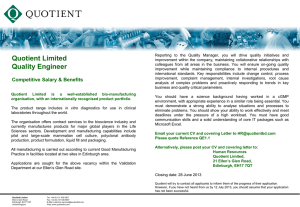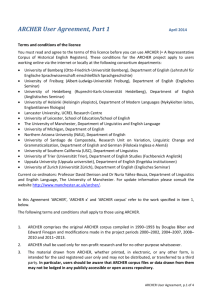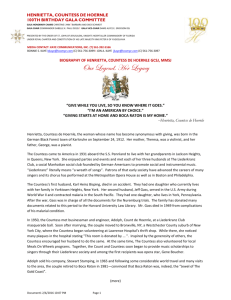The Age of Innocence
advertisement
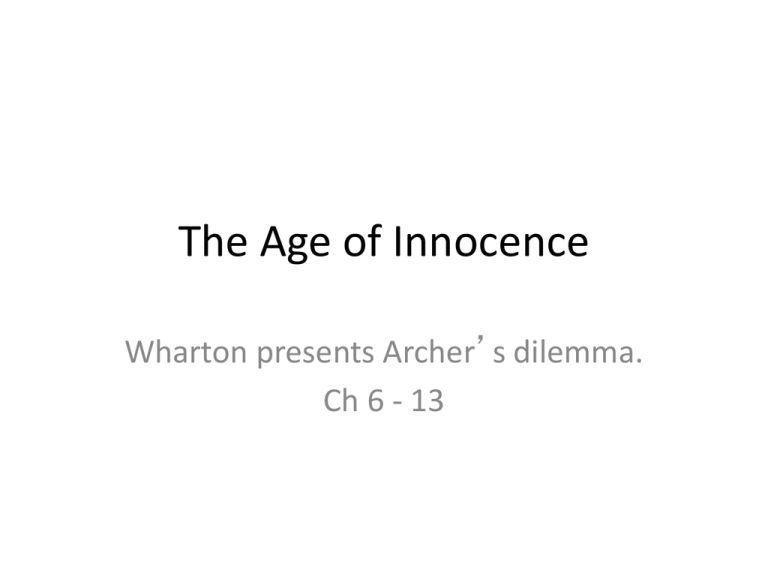
The Age of Innocence Wharton presents Archer’s dilemma. Ch 6 - 13 Mid Year Exam • Please note that you will need to have your examination text • Unseen poetry • The Age of Innocence Chapters 1 - 10 Chapter 6 • The chapter opens with a distinct sense of Newland Archer’s new dilemma – the dilemma created by Ellen Olenska’s return to New York society “The case of the Countess Olenska had stirred up old settled convictions and set them drifting dangerously through his mind. (p35) Chapter 6 “Of course the dilemma was purely hypothetical; since he wasn’t a blackguard Polish nobleman…” p36 •The concept of ‘freedom’ for the modern woman is addressed – “But here he was pledged to defend, on the part of his betrothed’s cousin, conduct on his own wife’s part, would justify him calling down on her all the thunders of Church and State” Chapter 6 “He reviewed his friends’ marriages – the supposedly happy ones – and saw none that answered, even remotely, to the passionate and tender comradeship which he pictured as his permanent relationship with May Welland” p36 “Lawrence Lefferts occurred to him as the husband who had most completely realised this enviable ideal.”p36 – note the irony – “he had formed a wife so completely to his own convenience” Chapter 6 • What of the presentation of May Welland? “She was frank, poor darling, because she had nothing to conceal, assured because she knew of nothing to be on her guard against; and with no better preparation than this, she was to be plunged overnight into what people evasively called ‘the facts of life.’” p37 Chapter 6 • The concept of “form” is accurately described thus; “In reality they all lived in a kind of hieroglyphic world, where the real thing was never said or done or even thought, but only represented as a set of arbitrary signs” p36 Chapter 6 • The key concept of the chapter is the focus on social insult after Mrs Manson Mingott’s invitation to meet Countess Olenska is turned down by almost all of New York society • Archer’s appeal to his mother drives Mrs Archer to approach the van der Luydens in order to ‘right the social wrong’ Chapter 7 • The van der Luydens listen to Mrs Archer’s appeal and eventually concoct a scheme by which Ellen will be ‘reabsorbed’ into New York society upon the return of their cousin the Duke of Austry • The talk focuses upon Lawrence Lefferts who is deemed to be behind the public snub of Ellen Olenska Chapter 7 • The chapter is short but there are some useful concepts embedded in the text that are useful to the advanced reader • In particular is the use of ‘knowing glances’ between characters such as; “Their pale eyes clung together in prolonged and serious consultation; then a faint smile fluttered of Mrs. Van der Luyden’s face. She had evidently guessed and approved” p46 Chapter 7 • Most notable is the reaction of the club box after these arrangements; “that evening at the Opera Mr. Sillerton Jackson was able to state that the envelope contained a card inviting the Countess Olenska to the dinner that the van der Luydens were giving…” “glanced sideways at Lawrence Lefferts who sat carelessly in the front of the box, pulling his long moustache…” p47 Chapter 8 • The chapter is mainly concerned with the dinner at the van der Luydens • The principal figures in the chapter are Newland Archer and Countess Olenska • Despite the rumours that Ellen has ‘lost her looks’ p48, Archer quickly reassesses her beauty upon seeing her; “there was about her the mysterious authority of beauty, a sureness in the carriage of her head” p 50 Chapter 8 • The concepts of family and family history are inevitably brought into the chapter • Ellen Olenska (previously Ellen Mingott) is the niece of Medora Manson (whose most recent married name is Chivers) and whose mother in turn was a Rushworth. • The nature of which family holds most power remains a social ‘secret’ held by a narrator who assumes that we follow the train of thought. Chapter 8 • It is worth noting Newland Archer’s duality of character in relation to Countess Olenska and the expectations of New York society “It was for such distinctions that the young man cherished in old New York even while he smiled at it” p50 • Archer’s attitude throughout the chapter reflects this same division and this is further extended in the chapters which follow Chapter 8 • The Europe/New York ‘split’ is constantly repeated especially in this chapter. • Newland’s mother is a perfect representation of the ‘correctly’ presented woman; “reminded her son of an Isabey miniature” p 51 • The Duke too seems almost out of place – he is only treated with reverence because of his connection to the van der Luydens Chapter 8 • A clear example of the dilemma that is to come is shown as Archer watches Ellens behaviour and apparent ‘lack of ettiquette’ p52 – “it was not the custom…the countess was apparently unaware of having broken any rule.” • We should note how Wharton’s narrator leaves the reader to decide whether Ellen is aware or not Chapter 8 • An interesting exchange occurs during Archer’s conversation with Ellen When she asks “Are you very much in love with her?” he replies; “As much as a man can be” to which she responds; “Do you think, then, there is a limit?” p52 Chapter 8 • May Welland’s entrance at the van der Luyden’s is theatrical and once again, clothing denotes status and virtue “ her dress of white and silver, with a wreath of silver blossoms in her hair. The tall girl looked like Diana alighting for the chase” p57 • Q: Why is Newland a dinner guest but May only an “after dinner guest”? Chapter 8 • The chapter’s ending has a classic moment of suggestion “ just touching his knee with her plumed fan. It was the lightest touch, but it thrilled him like a caress.” p53 • This is immediately followed by her invitation and Mrs van der Luyden’s ‘reminder’to “dear Newland” of his fiance’s beauty Chapter 9 • The much awaited meeting with Countess Olenska is delayed by Wharton’s narrator • The opening of the chapter focuses on Archer’s desire to marry more quickly – he is, ironically, frustrated by the requirements of “form” because of the “round of family visits” p 55 Chapter 9 • The appearance of Ellen in the chapter is further delayed by her late appearance • This allows Wharton’s narrator to focus on the house both externally and within • We are also informed that Newland has not told May of his visit to Ellen’s house – why is this? Chapter 9 • The descriptions involve colour, art and decoration upon a backdrop of shabbiness and decay • Archer surmises that Ellen has most likely lost her fortune to Count Olenski • However – this description indicates that he is clearly ‘excited’ by what he observes • What does the description suggest? Chapter 9 • Newland’s response to Ellen’s art and furnishings suggests further confusion – a physical representation of his forthcoming dilemma? • His knowledge of art is like his knowledge of ‘form’ because it is studied (Ruskin et al p 57) • His mind wanders to his future as he waits (p58) – note “The young man felt that his fate was sealed: for the rest of his life…she would probably let him arrange his library as he pleased…” Chapter 9 • We are allowed a glimpse of Archer’s future awareness of his world in his naïve thoughts (p61) “she did not begin to see…how nearly it had crushed her…The Lovell Mingott’s dinner…ought to have taught her the narrowness of her escape” • “It’s you who are telling me; opening my eyes to things I’d looked at so long that I’d ceased to see them.” Chapter 9 • It is as he discusses the perils of New York society that Ellen discusses her true situation and appears most vulnerable • It is at this point that Archer first uses the name “Ellen” – p63 • “He drew down one of her hands, clasping and chafing it like a child’s while he murmured reassuring words; but in a moment she freed herself and looked up at him with wet lashes.” Chapter 9 • The chapter notably closes with the reference to the yellow roses • Wharton’s use of symbolism is very clear here • Lillies-of-the-valley for May • Yellow roses for Ellen Olenska Chapter 10 • The principal concern of the chapter is once again to establish the nature of New York society’s rigidity when it comes to expected behaviour. • It is comical to note that exceptions are tolerated – especially ‘foreign’ figures such as the Duke • However, it is notable that Countess Olenska is not included in this category Chapter 10 “Countess Olenska is a New Yorker, and should have respected the feelings of New York” p72 •What is especially interesting is the way Mrs Archer considers New York – like a living, conscious being rather than merely as a place. Chapter 10 • Also notable are the increasing number of ‘clues’ to a change in the way in which Archer perceives Ellen “I’m not engaged to be married to the Countess Olenska!” The words had a fantastic sound in his own ears. P 70 Chapter 10 • The true impact of the chapter is subtly embedded in Janey’s; “Gracious – how romantic!” p 74 • The family members do not grasp her “elliptic comments” but this is because the statement is really intended for the reader. It signals Wharton’s introduction of the concept of a ‘reckless’ romance “Provided it all turns out for the best,” she said, in a tone of one who knows how surely it will not.”
